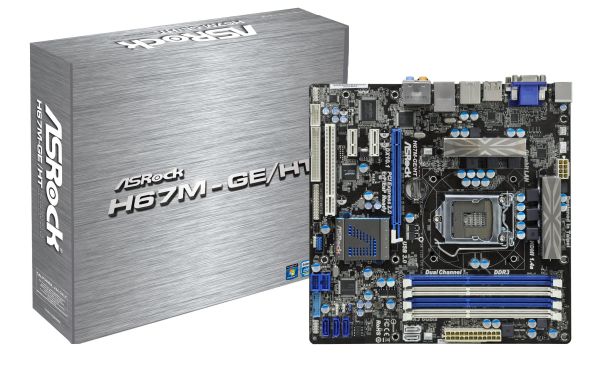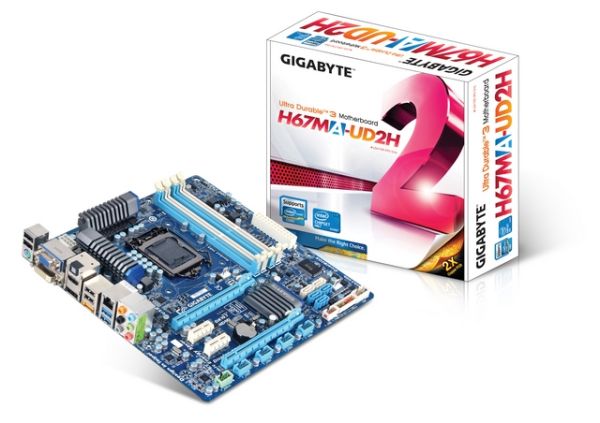H67 – A Triumvirate of Tantalizing Technology
by Ian Cutress on March 27, 2011 6:25 PM EST- Posted in
- Motherboards
- Sandy Bridge
- H67
Overview
With Intel’s recall at the beginning of the year, just after release, vendors are now starting to make versions of their fixed chipsets available to end users. As I mentioned at the very beginning of this review, what we are technically looking at are the B2 samples, as these were distributed to us before the recall. Every manufacturer here has confirmed that the B3 versions of these boards perform exactly the same as the B2, but will either be released with the same name but a B3 sticker on the box, or the name will be adapted with the B3 edition – so the Gigabyte H67MA-UD2H becomes the Gigabyte H67MA-UD2H-B3.
With H67, we lose the CPU overclocking of the P67 and all the dual GPU lanes, and instead get access to the integrated GPU on the processor. As a result, manufacturers do not have to provide the H67 with oodles of high-quality VRMs to hold high CPU overclocks amongst other things, which bring the costs down. As such, our boards here are $120 (ASRock), $140 (ECS) and $125 (Gigabyte).
ASRock H67M-GE/HT
The ASRock H67M-GE/HT is relatively easy to use and performs well in our benchmark suite. At $120, with the additions in the package in the board, makes this a relatively comfortable H67 product. It does not have the features of some of the more expensive boards, such as a Debug LED and Power/Reset buttons, but once the board is installed in a case, it is quite rare that you will need these again. The board has legacy floppy connectors and a PS/2 keyboard port, which may be a selling point for some buyers still running legacy equipment. The H67M-GE/HT also runs cooler than other Sandy Bridge boards I have tested. The ASRock board comes with a one year warranty, with an option to extend for another year.
ECS H67H2-M
The ECS H67H2-M has a few serious check points against it as a board to use. The RAM timings in the BIOS are not changeable; the BIOS can be hard to navigate and does not implement any of the newer UEFI principles coming through with Sandy Bridge; the USB performance is sub-par, and the DPC Latency is the highest of the H67 boards we have tested. There are some very positive points with it – eJiffy is a great piece of software, you have double gigabit Ethernet ports, Power/Reset buttons on the board and a Debug LED, the 2D performance is better than average, and your fan options are better than some other vendors. I would prefer to see a cleaner BIOS, more fan headers and better USB performance become as standard. The ECS board comes with a three year warranty.
Gigabyte H67MA-UD2H
The Gigabyte H67MA-UD2H does not have a lot of physical features, unless you have need of lots of external USB ports. While it offers some BCLK overclocking, there are not enough fan headers on the board to support basic all-in-one water cooling, or more than one case fan. The SATA ports are oddly further into the board which is not ideal. The BIOS is however rock solid and simple to use, which is no small feat. The PCIe slots are not ideally laid out (I would prefer x1, x16, x1, x4), and in their current configuration would restrict RAM coolers when using a dual slot, long GPU. There are no Power/Reset buttons, no Debug LED, but the software included works and does its job. For $125, the ASRock beats it in bang for buck, but people will not be disappointed if they picked up the H67MA-UD2H (or rather, its B3 equivalent, the H67MA-UD2H-B3). The Gigabyte board comes with a three year warranty.
Conclusion
There are a lot of options in the world of H67 but there are also a lot of pitfalls. For a board to have all the bells and whistles (presumably, some imaginary board with all the best bits from every other board), you would easily be pushing into P67 price territory and then some more. There is not much between all the boards in terms of performance, so you may end up looking at what is included with the board or features for a final decision.
The biggest surprise for me however is the loss of a multiplier on single-threaded loads on H67. On all three boards, the BIOS/UEFI had 37x multiplier set for single thread loads, but in the OS, it would only ever go to 36x. We're told that this is part of the Intel chipset specifications for H67, but this ultimately means that the consumer is losing that multiplier. Only with the Gigabyte board (out of these three) can you overcome this with BCLK overclocking, but ultimately that overclocking can be quite variable chip-to-chip.



01_575px.png)









56 Comments
View All Comments
bupkus - Monday, March 28, 2011 - link
Agreed. The i3-2100 is a true budget cpu, imho. It should be matched with a true budget mobo-- namely the H61. I hope to see some more info on boards made with that chipset.Taft12 - Monday, March 28, 2011 - link
It's not accurate to call the i3-2100 a "true budget CPU" while we've got stuff like the Athlon II X2 and Pentium E5xxx on the market.cjs150 - Monday, March 28, 2011 - link
I am pleased you said this, because this is something I do not understand either, H67 looks to be a waste of timeASrock seems the best of this silly catagory. I have one of their boards in a file server, nice board, just works without fuss. Perfect for a server. May look at them for next build, instead of my usual ASUS fetish.
One thing though that really bugs me. Why on all the Micro-ATX boards out there do they insist on having the top PCI-E so close to the bottom end of the memory sockets. Have the MB manufacturers not noticed that high end memory is shipping with cooling fans? Several times I have found it impossible to fit a graphics card and the memory fan, virtually every time at the very least I have to ensure that there are no possible shorts by putting electricians tape around the bottom of the memory fan clup on. MB manufacturers it is not difficult, move the PCI-E slot down by 5mm or the memory sokets up by 5mm
bigboxes - Monday, March 28, 2011 - link
Not a bash, but fans on DDR3 ram is mostly frivolous waste. Heck, most ram today doesn't even need fancy heatspreaders because they run so cool. This is about the H67 chipset so I don't think many would waste time/money on buying high end memory that offers little in the terms of performance. Don't worry, Z68 is coming soon and you'll be able to buy your full ATX board that you can load up with the latest and greatest in parts to get that XTREME o/c. This chipset is not marketed for you.ArtShapiro - Monday, March 28, 2011 - link
I'd like to think that I (a decided non-gamer) am the target audience.I currently have a physically large (huge?) desktop system in a Chenboro 105 case. No way this monster can fit in the alcove in my computer desk, so it sits on the floor with the usual scads of cables coming from the desk. What a royal pain to move, clean, etc.
I suspect this summer I'll have an H67 system in a tiny (maybe Antec 300-150) case, little bigger than my tiny Asus TS mini Windows Home Server machine. With no graphic card, this thing should be efficient and dwarf the performance of the existing monster.
The H67 setup fits my needs to an alarming degree!
Art
Concillian - Tuesday, March 29, 2011 - link
What about this system cannot be handled by a significantly cheaper H61 motherboard? I missed that part of why H67 was perfect.
Taft12 - Tuesday, March 29, 2011 - link
He's not a gamer, but maybe he wants the SATA 6Gbit ports? 4 memory slots? USB 3.0?H61 boards are lacking, well, a lot if you're want anything beyond ultra-entry-level.
ArtShapiro - Wednesday, March 30, 2011 - link
Pure power. The cost is irrelevant (within reason); the increased processor of, say, the 2500/2500K will be a nice thing in processor-heavy applications and will probably ensure a longer relevant lifetime for the machine.I figure it's worth it to shell out a little more upfront for the H67.
Art
bobbyto34 - Monday, March 28, 2011 - link
Thanks a lot for testing DPC Latency. This can be a major issue for DAW's users.Spoelie - Monday, March 28, 2011 - link
I would concede that an integrated GPU is a very valuable tool for any computer user. It can be used to eliminate variables when troubleshooting a system, and to prevent downtime when the discrete GPU passes away. For this reason and this reason alone I personally don't buy a system without an integrated GPU anymore, even though I always have discrete GPUs. At least in 2 cases this has helped me tremendously.My personal preference is a cheap but good overclocking mATX board with (support for) iGPU & at least 1 eSATA port. Couldn't care less about SLI/XFire & RAID5, so the 785+SB710 board I now use was perfect, but without USB3 and SATA6 it's starting to show its age. One of the reasons I haven't switched to SNB is that Intel can't provide me that platform yet.
Here's to hoping for cheap mATX Z68 and cheap(er) K series CPUs.